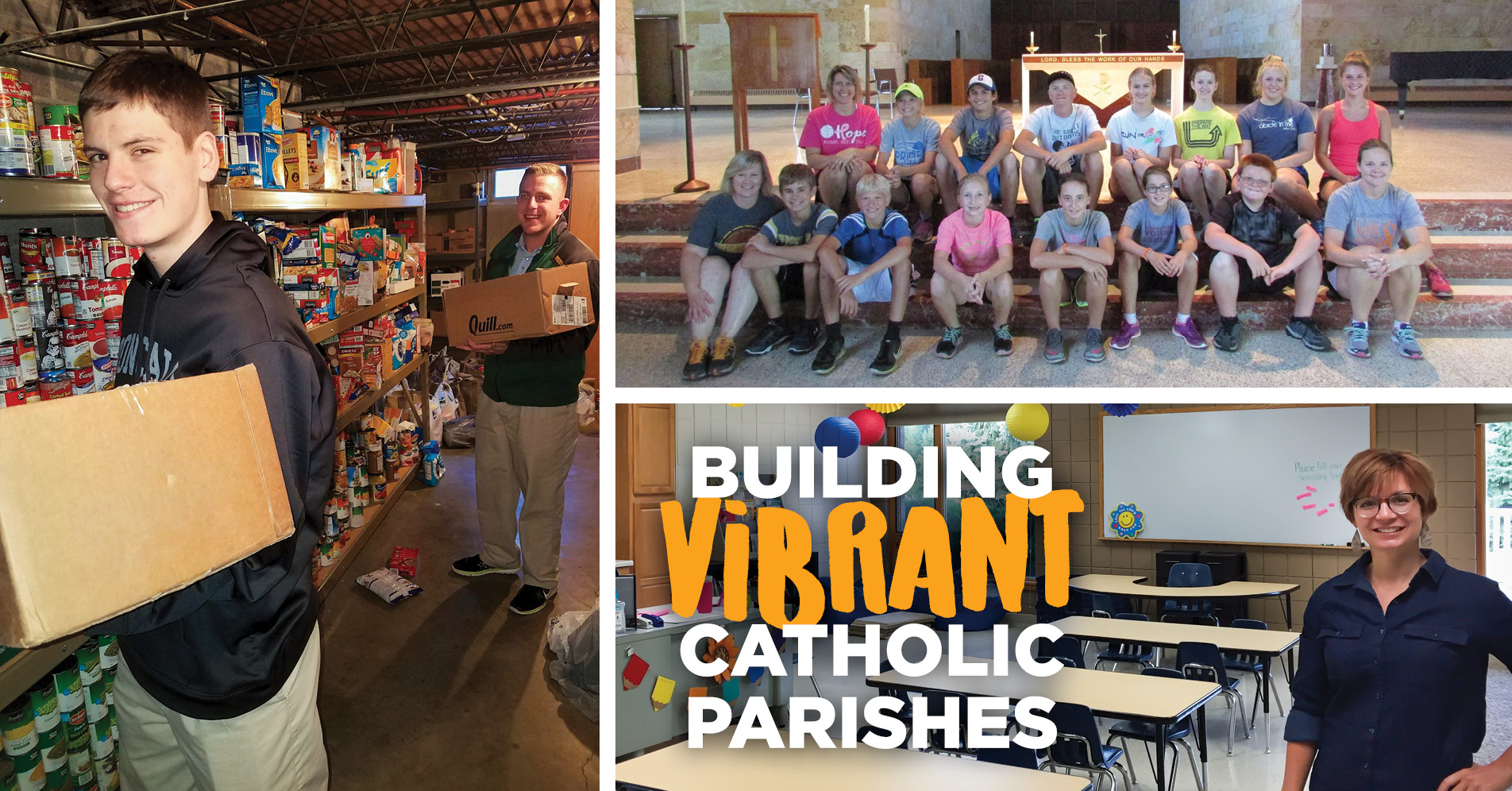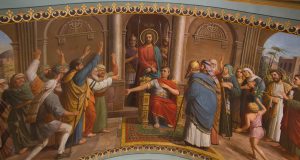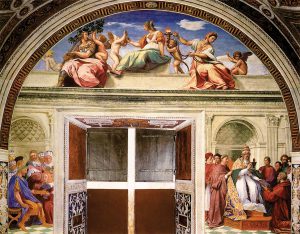

by Maricarrol Keuter for the Bishop’s Bulletin
Some rural families in eastern South Dakota drive up to 45 miles to attend Sunday Mass.
These dedicated parishioners are key members of their faith communities. But for a pastor, the idea of cultivating an active parish life with such a far-flung population may seem daunting.
From his vantage point as a rural pastor, Father Mike Kelly has seen something quite different.
Kelly leads the merged Conde, Doland and Turton parishes – now centered in St. Joseph, Turton. In recent years, he has watched a lively, faith-filled church community come together.
“The parish is energized; the church faith community is alive and sustainable and those qualities will spill over into the entire community,” Father Mike Kelly wrote in a report in April 2016.
Brian and Jamie Johnson’s family were among those who became new members of St. Joseph after the 2011 consolidation.
“When we joined St. Joseph in Turton it was a time of great transition in the area with the closure of many parishes,” recalls Jamie Johnson. “Everyone was very welcoming when we started attending Mass there. As the years have passed I feel like we are no longer people from various closed parishes but all parishioners of St. Joseph, Turton.”
The 119 parishes in the Catholic Diocese of Sioux Falls range in size from several dozen to more than 1,500 families. Some churches are nestled into busy urban neighborhoods; many stand as fixtures in small towns and several are situated along sparsely traveled rural roads. Whatever the size, each parish is called to create and sustain a healthy, spirit-filled community of believers.
While the parishes take various approaches to building and maintaining such vibrancy, one principle is shared by all.
“It’s not a pastor thing; it’s a people-in-the-pews thing’” said Father Michael Griffin, pastor of St. Mary Church in Aberdeen.
The Catholic Church stresses the importance of lay people in parish life.
“Lay believers are in the front line of Church life,” according to the Catechism of the Catholic Church. “For them, the Church is the animating principle of human society. Therefore, they in particular ought to have an ever-clearer consciousness not only of belonging to the Church, but of being the Church, that is to say, the community of the faithful on earth under the leadership of the Pope, the common Head, and of the bishops in communion with him. They are the Church.”
Merger creates new parish, new challenges
Few parishes face the unique challenges that a handful of small rural parishes in north-central South Dakota did in 2011. After several years of study, meetings and discussion, a diocesan-wide pastoral planning process determined consolidation was the best route forward for the communities of Turton, Conde and Doland. At the same time, the small parish in Bristol joined with the neighboring Groton parish.
Les and Julie Hinds, members of St. Elizabeth Seton in Groton, watched the transition and understood the anxieties of the transplanted members.
“Of the parishes that merged, they still have their loyalties to their home parish. The cemeteries are still in those communities and burials will still take place there,” Hinds said.
But before long, the newly merged parishes started to come together and the parishioners formed a welcoming, inclusive environment.
Today, Father Kelly said, the church communities are thriving. That’s due in large part to what he calls the “ownership attitude” among the parishioners.
“It’s the people’s church,” said Father Kelly. “The liturgy is the work of the people. … priests come and go, parishioners remain and get involved and bring life and energy into the parish, making it vibrant and life giving. This full, conscious, active participation in caring, supportive, loving ways is what makes parish life so active. We are gift to each other.”
The Johnsons have four children and live south of Frankfort, SD. They are active in the Turton parish. Jamie is a member of the parish council and serves as a lector, and religious education teacher. Daughters, Ella and Lila, serve Mass.
“We have a healthy mix of parish members from young families with little kiddos to middle age empty nesters to the elderly. Our parish captures a lot of land area where people travel close to 30 miles to come to Mass,” said Jamie Johnson.
In Brookings, a parish stretches to serve more
St. Thomas More is a strong, active congregation. As part of its regular outreach, the parish tithes to Brookings community organizations, a giving tradition that parishioners cherish, said Father Terry Anderson, pastor of St. Thomas More.
So about five years ago, when a group of families proposed that the parish consider building a school, many hesitated. They wanted to make sure their long tradition of tithing wasn’t going to be threatened by the budget needs for operating a school.
The idea resurfaced last year. Proponents pointed out that theirs was the biggest parish in the diocese not to operate a school. St. Thomas More was offering pre-school and pre-kindergarten programs at the time.
This was an opportunity for an already vibrant parish to do more and expand its ministry to a new population – students and their families.
Father Anderson brought together parish members and groups for discussion on the idea. After a few months, the parish council agreed to expand their parish’s outreach efforts by starting a school.
The parish has decided to begin small by adding a kindergarten class.
Since parishioners were adamant about not interfering with their active community tithing program, parish leaders agreed to find the money for the school outside the regular budget. They put together a combination of tuition charges, contributions from a foundation and a drive for individual contributions to finance the kindergarten program.
The school has 12 families committed, a teacher has been hired and the class will convene this fall.
“There are exceptional families who have put in a lot of work, a lot of time and made financial contributions to get this done,” said Fr. Terry Anderson.
Two parishes in cooperation in Aberdeen
In Aberdeen, there are two longstanding, vibrant parishes. Separated by only a few blocks, the congregations of St. Mary and Sacred Heart had been congenial, but slightly competitive neighbors for years.
That started to change several years ago when pastors decided to cooperate to consolidate and strengthen their Catholic school system. Instead of operating separate elementary schools, they merged into one system, with K-2 grades and pre-school at St. Mary and other elementary classes at Sacred Heart. Middle and high school students attend classes on the Roncalli High School campus.
When two new priests – Father Michael Griffin at St. Mary and Father Mark Lichter at Sacred Heart – came to Aberdeen in the summer of 2015, they agreed to actively explore additional avenues of cooperation.
The priests thought both parishes would benefit “if we could work together in a more systematic way,” said Father Griffin.
They worked with the school board and Roncalli High School to establish a new Aberdeen Catholic Foundation. That organization now works to provide additional funds for the stability of both parishes.
The two priests meet once a week to talk and they’re currently holding listening sessions to explore additional areas of potential cooperation. Next year, for example, the parishes plan a combined Confirmation ceremony.
“The image we tend to use is to think of it as a married couple,” said Father Griffin. “We retain our individuality, but we can be better together”, he said.
Both parishes are lively, vibrant and faith-filled. The cooperation is designed to give them even more opportunity for spiritual and charitable growth. There is no intent to merge the parishes into one.
“Right now we’re just brainstorming ways we can be as efficient as possible and support and strengthen the lives of parishioners,” Father Griffin said.
“It’s a mindset really. We succeed better together than we ever would alone.”
Keys to vibrancy in parishes
There’s no set formula for vibrancy in parish life. But there are some common characteristics found in healthy parishes, diocesan officials say.
People working in community, strong prayer lives and support for each other are necessary, according to Daryl Thuringer, Delegate for Discipleship and Evangelization and Director of Parish Services for the Diocese of Sioux Falls
“As a parish we are called to be community, to support each other and those around us. That support is key in prayer, meeting material needs and service beyond the parish,” Thuringer said. “A parish community that is engaged in serving each other and praying for each other will be a vibrant community.”
Dr. Chris Burgwald, director of Adult Discipleship and Evangelization for the diocese, says spiritual vibrancy has “both an inward and an outward dimension: Jesus calls us to go out and make disciples, but to do so requires first going in and attending to our own spiritual life.”
“We are called to bring the Good News of Jesus Christ into all aspects of our lives, so that through contact with us, others can ‘bump up against’ Jesus. Not only that, but He also commanded us to love our neighbor, so all of us are called to pray and reflect on how we can best love and serve those around us, whether it be in our neighborhood, our workplaces, where we shop… wherever it is that God is directing our attention in a particular way,” he said.
The more the parish attends to both – the inner spiritual life of parishioners as well as their outreach activities – the more vibrant it will become,” he said.
What can individuals do to help create vibrant parishes?
Parishes sometimes struggle to get parishioners involved, to encourage them to work together as a team, and to learn to stretch beyond satisfying individual prayer needs.
Especially in a time where individuality is a cultural hallmark, pastors say the notion of a community of believers working together, supporting one another in Christian service, is unique.
Yet that is the essence of Catholicism.
“Catholicism has always been communal,” said Father Griffin. “From the gathering of apostles in the Upper Room to St. Mary Church in 2017, it’s always about the strength we get from community.”
So, what can one person, one couple or a single family do to help their parish become healthier and more vibrant?
“The simplest — but not necessarily easiest — thing to do is to focus on your own spiritual life: your daily prayer life, your participation in the sacraments, your knowledge of Church teaching etc.,” said Burgwald. “Parish vibrancy comes from the vibrancy of its members, so the more each of us is attentive to our own spiritual life, the more vibrant our parish will become.”
Thuringer agrees that prayer is essential.
“Saint Paul wrote to the Thessalonians to pray without ceasing. A parish community needs to pray -without ceasing – for each other. It is everyone’s role to be active in the prayer life of the parish that includes Masses, adoration and daily prayer,” he said.
Jamie Johnson sees the importance of being involved in parish life.
“It is very important for individuals and families to be active in parish life because it helps those people grow in their spiritual life. The more we are servants toward others the more Christ-like we become and in turn grow in our relationship with Christ,” she said.
Practical steps such as Bible studies, prayer groups and involvement in social ministry activities are good first steps for any parishioner, pastors say.
“Every parish needs to follow the example set by St. Benedict in his rule for monastic communities by offering hospitality. Welcome the stranger, include the lonely and embrace the sick are goals for home visits, Bible studies and prayer chains, all of which build stronger communities,” Thuringer said.
Father Kelly said his combined rural parish grew and matured as each parishioner brought individual gifts to the table.
“It’s about welcoming and bringing in the gifts that each parishioner provides,” he wrote in 2016. “Everyone comes with gifts; they bring what they are, what they have. When asked to bring one’s gifts, one feels valuable, wanted and needed.”
In Groton, long-time parish member Julie Hinds says a vibrant parish is possible only because of the efforts of members of all ages.
“St. Elizabeth Ann Seton is a healthy and vibrant parish because of the work of many families both older and younger. It is the younger families that are most important as they will carry on the way of the parish as more of the older parishioners are less active. We have a handful of younger families who demonstrate great care for the functioning of the parish,” she said.
Burgwald said Catholics are “unable to truly flourish in our spiritual life without others.”
“Whether it be the sacramental ministry offered by our priest, the friendship and accountability offered by a fellow parishioner, or the teachings of Jesus passed on to us by the pope and the bishops, we are truly dependent on others for our spiritual vibrancy.”
Thuringer said individuals “experience parish unity at a personal level and give back to the unity of the parish individually.”
“It is each member’s responsibility to be active and participate in the parish and constantly keep refreshing the circle of life in the parish,” he said.
Building a new Catholic community
“Christ must be first.” This is the secret for Fr. John Rutten as he experiences the blessings and challenges of creating a new Catholic community in the Harrisburg area. “I am reminded of the words of Pope Francis, ‘Jesus Christ is always first, He primareas us, awaits us, Jesus Christ always precedes us; and when we arrive, He has already been waiting.’ These words give me much peace and confidence, because they place the primary effort upon God.
“I remember with great anticipation the days leading up to my arrival. I was eager to see what the Lord had in store. In terms of typical parish structures there was nothing there: no church building, no office, no school, no rectory, no staff. Thinking of all the missionary priests and people of years gone by, it sounded adventurous. In reality it became a difficulty, which was only lifted by entering into the lives of the people God entrusted me to, and admitting total dependence upon the Mystery of Christ. I have discovered in this dependence that vibrancy does not happen because we plan well or because we organize things correctly or even solve everyone’s problems. The vibrancy, which we long for is to recognize Christ who beats within our human hearts. When this happens we possess joy and we permit all things to fall into place according to His will.”
In less than one month the Harrisburg area Catholic community has been astonished at all that has fallen into place. The first staff member, Paul Moneke, arrived within a few weeks to serve as mission coordinator (which includes religious education, administration and music/liturgy). A temporary location was established, including a chapel for daily Mass and offices. Office furniture, supplies, printer, computer software, a Roman Missal are among the many items which have arrived to supply the needs. “Even the children were asked to make some sacrifices from their piggy banks. I was moved to think that in 40 or 50 years, a little kid might consider that they contributed, maybe just a pencil, to the needs of the parish: but a pencil from a little person’s piggy bank is the widow’s mite,” he said.
Fr. Rutten acknowledges gratitude: “We are grateful for all the ways the Lord has blessed us in the first days of this new journey. Most importantly we are grateful that He has come first, has prepared a place for us, and calls each of us by name. We look forward to all the people He will call into our vibrant new community in the Harrisburg area.” The community thanks God foremost each Sunday at Mass, which is celebrated at the Harrisburg High School.


